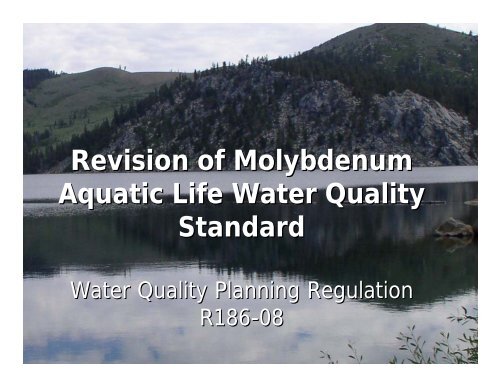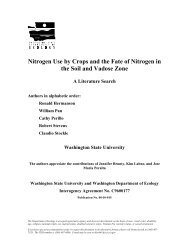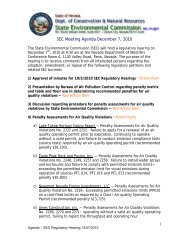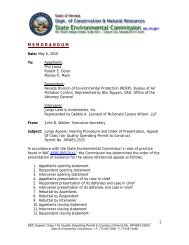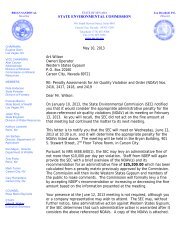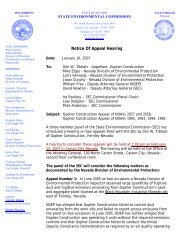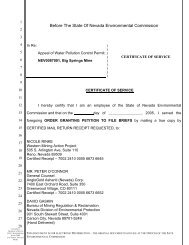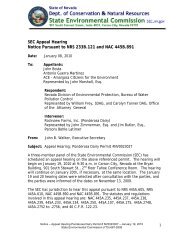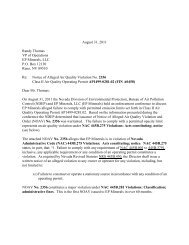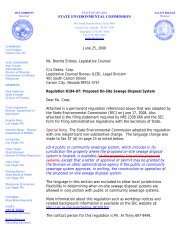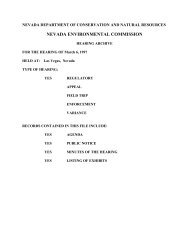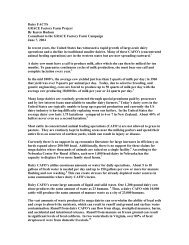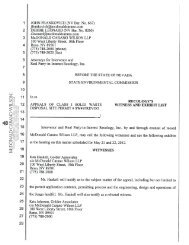Revision of Molybdenum Aquatic Life Water Quality Standard
Revision of Molybdenum Aquatic Life Water Quality Standard
Revision of Molybdenum Aquatic Life Water Quality Standard
You also want an ePaper? Increase the reach of your titles
YUMPU automatically turns print PDFs into web optimized ePapers that Google loves.
<strong>Revision</strong> <strong>of</strong> <strong>Molybdenum</strong><br />
<strong>Aquatic</strong> <strong>Life</strong> <strong>Water</strong> <strong>Quality</strong><br />
<strong>Standard</strong><br />
<strong>Water</strong> <strong>Quality</strong> Planning Regulation<br />
R186-08
Regulatory Background<br />
• Current Nevada standard is 19 µg/L (NAC 445A.144)<br />
– Derived in California RWQCB report for the San<br />
Joaquin River<br />
– Based on toxicity data for three species and national<br />
background Mo concentration<br />
– Not calculated using EPA methods – Not based<br />
primarily on toxicity data as required<br />
• No EPA national aquatic life criteria<br />
– Many states have no aquatic life WQC for Mo
Derivation <strong>of</strong> Current Mo <strong>Standard</strong><br />
Species<br />
rainbow trout<br />
narrow-mouthed toad<br />
Daphnia magna<br />
Geometric Mean<br />
Effect Level:<br />
Effect Level<br />
(µg/L)<br />
120<br />
960<br />
1150<br />
510<br />
Citation<br />
Birge et al., 1980<br />
Birge, , 1978<br />
Kimball manuscript<br />
Geometric mean <strong>of</strong> effects level (510 µg/L) and national ambient<br />
background concentration (0.68 µg/L) = 19 µg/L
Evaluation <strong>of</strong> <strong>Molybdenum</strong> <strong>Aquatic</strong><br />
<strong>Life</strong> <strong>Standard</strong><br />
• Review all relevant Mo toxicity studies<br />
• Evaluate aquatic life toxicity data<br />
– Substantiate current standard<br />
or<br />
– Develop revised water quality standard
Acute Test Data<br />
Rank<br />
Species<br />
Common Name<br />
Acute Effect Level<br />
(mg Mo/L)<br />
15<br />
Ictalurus punctatus<br />
channel catfish<br />
10,000.0000<br />
14<br />
Chironomus tentans<br />
midge<br />
7,533.3000<br />
13<br />
Lepomis macrochirus<br />
bluegill<br />
6,790.0000<br />
12<br />
Gammarus fasciatus<br />
scud<br />
3,940.0000<br />
11<br />
Crangonyx pseudogracilis<br />
isopod<br />
2,650.0000<br />
10<br />
Oncorhynchus mykiss<br />
rainbow trout<br />
2,269.4034<br />
9<br />
Daphnia magna<br />
cladoceran<br />
2,218.0871<br />
8<br />
Oncorhynchus nerka<br />
kokanee salmon<br />
2,000.0000<br />
8<br />
Catostomus commersoni<br />
white sucker<br />
2,000.0000<br />
7<br />
Catostomus latipinnis<br />
flannelmouth sucker<br />
1,940.0000<br />
6<br />
Girardia dorotocephala<br />
flatworm<br />
1,225.6000<br />
5<br />
Ceriodaphnia dubia<br />
cladoceran<br />
1,015.0000<br />
4<br />
Oncorhynchus kisutch<br />
coho salmon<br />
1,000.0000<br />
4<br />
Oncorhynchus tshawytscha<br />
chinook salmon<br />
1,000.0000<br />
3<br />
Pimephales promelas<br />
fathead minnow<br />
253.8110<br />
2<br />
Euglena gracilis<br />
protistan<br />
72.3000<br />
1<br />
Tubifex tubifex<br />
tubificid worm<br />
28.9100
Chronic Test Data<br />
Rank<br />
Species<br />
Common Name<br />
Chronic Effect<br />
Level<br />
(mg Mo/L)<br />
5<br />
Oncorhynchus mykiss<br />
rainbow trout<br />
866.0254<br />
4<br />
Pimephales promelas<br />
fathead minnow<br />
163.5427<br />
3<br />
Daphnia magna<br />
cladoceran<br />
97.0183<br />
2<br />
Ceriodaphnia dubia<br />
cladoceran<br />
60.4380<br />
1<br />
Catostomus commersoni<br />
white sucker<br />
1.7000
Review <strong>Aquatic</strong> <strong>Life</strong> Toxicity Data<br />
• Laboratory toxicity test results indicated<br />
higher thresholds to molybdenum<br />
• Current molybdenum standard based on<br />
limited toxicity data<br />
• Sufficient toxicity data available to use<br />
EPA standard method for revised criteria<br />
development
Guidelines for Deriving Numerical National<br />
<strong>Water</strong> <strong>Quality</strong> Criteria for the Protection <strong>of</strong><br />
<strong>Aquatic</strong> Organisms and their Uses<br />
(EPA 1985)<br />
• Screening criteria for toxicity test data<br />
• Minimum data requirements for<br />
developing criteria<br />
• Procedures for calculating criteria
Acute Test Data<br />
Rank<br />
Species<br />
Common Name<br />
Acute Effect Level<br />
(mg Mo/L)<br />
15<br />
Ictalurus punctatus<br />
channel catfish<br />
10,000.0000<br />
14<br />
Chironomus tentans<br />
midge<br />
7,533.3000<br />
13<br />
Lepomis macrochirus<br />
bluegill<br />
6,790.0000<br />
12<br />
Gammarus fasciatus<br />
scud<br />
3,940.0000<br />
11<br />
Crangonyx pseudogracilis<br />
isopod<br />
2,650.0000<br />
10<br />
Oncorhynchus mykiss<br />
rainbow trout<br />
2,269.4034<br />
9<br />
Daphnia magna<br />
cladoceran<br />
2,218.0871<br />
8<br />
Oncorhynchus nerka<br />
kokanee salmon<br />
2,000.0000<br />
8<br />
Catostomus commersoni<br />
white sucker<br />
2,000.0000<br />
7<br />
Catostomus latipinnis<br />
flannelmouth sucker<br />
1,940.0000<br />
6<br />
Girardia dorotocephala<br />
flatworm<br />
1,225.6000<br />
5<br />
Ceriodaphnia dubia<br />
cladoceran<br />
1,015.0000<br />
4<br />
Oncorhynchus kisutch<br />
coho salmon<br />
1,000.0000<br />
4<br />
Oncorhynchus tshawytscha<br />
chinook salmon<br />
1,000.0000<br />
3<br />
Pimephales promelas<br />
fathead minnow<br />
253.8110<br />
2<br />
Euglena gracilis<br />
protistan<br />
72.3000<br />
1<br />
Tubifex tubifex<br />
tubificid worm<br />
28.9100
Acute Criterion Derivation<br />
Rank<br />
Genus<br />
GMAV (mg/L)<br />
LN GMAV<br />
(LN GMAV) 2<br />
P = R/(N+1)<br />
P 0.5<br />
4<br />
Ceriodaphnia<br />
1,015.0000<br />
6.9226<br />
47.9230<br />
0.2857<br />
0.5345<br />
3<br />
Pimephales<br />
253.8110<br />
5.5366<br />
30.6538<br />
0.2143<br />
0.4629<br />
2<br />
Euglena<br />
72.3000<br />
4.2808<br />
18.3255<br />
0.1429<br />
0.3780<br />
1<br />
Tubifex<br />
28.9100<br />
3.3642<br />
11.3178<br />
0.0714<br />
0.2673<br />
Sum<br />
20.1042<br />
108.2200<br />
0.7143<br />
1.6427<br />
( )<br />
2<br />
⎛ ( ) ⎞<br />
2<br />
( ) ) ⎜ ∑ LN GMAV<br />
⎟<br />
∑ LN GMAV −<br />
⎜ 4 ⎟<br />
2<br />
S =<br />
⎝<br />
⎠<br />
= 180.7081<br />
2<br />
⎛ ( ( ) ⎞<br />
S = S 2 = 13. 4428<br />
( ) −<br />
⎜ ∑ P<br />
P<br />
⎟<br />
∑<br />
⎜<br />
⎝<br />
4<br />
⎟<br />
⎠<br />
( S( ( P<br />
)<br />
L<br />
A = S( 0 .05 ) + L = 2. 5114<br />
( ( ))<br />
∑<br />
= ∑ LN GMAV −<br />
4<br />
FAV<br />
Sample Size (N) = 13<br />
= e<br />
A<br />
= 12.3232<br />
= − 0.4944<br />
FAV<br />
2<br />
12.3232<br />
= = 6.1616<br />
2<br />
Criteria Maximum Concentration (CMC) =<br />
Acute Criterion = 6.16 mg Mo/L
Chronic Criterion<br />
• Too few chronic toxicity data to develop<br />
criterion via methodology used to derive<br />
acute criterion<br />
• Derive criterion by determining an acute-<br />
chronic ratio (ACR)
ACR Derivation<br />
Species<br />
Acute Value<br />
(mg/L)<br />
Chronic Value<br />
(mg/L)<br />
ACR<br />
Species<br />
Mean ACR<br />
Ceriodaphnia dubia<br />
1015.0<br />
76.9<br />
13.2<br />
13.2<br />
Pimephales promelas<br />
644.2<br />
163.5<br />
3.9<br />
3.9<br />
Daphnia magna<br />
1727.8<br />
153.8<br />
11.2<br />
22.9<br />
Daphnia magna<br />
2847.5<br />
61.2<br />
46.5<br />
Oncorhynchus mykiss<br />
2269.4<br />
866<br />
2.6<br />
2.6<br />
Final ACR<br />
7.5
Chronic Criterion Calculation<br />
Final Acute Value (FAV) ÷ ACR = Final Chronic Value (FCV)<br />
FAV (12.32 mg Mo/L) ÷ ACR (7.5) = FCV (1.65 mg Mo/L)<br />
FCV = Criteria Continuous Concentration (CCC) = Chronic Criterion<br />
Chronic Criterion for <strong>Molybdenum</strong> = 1.65 mg/L
Proposed Acute Mo AQLC <strong>of</strong> 6.16 mg/L
Proposed Chronic Mo AQLC <strong>of</strong> 1.65 mg/L
Summary<br />
• <strong>Molybdenum</strong> aquatic life criteria developed<br />
based on current toxicity data and EPA<br />
methods<br />
• Proposed criteria are well below values<br />
observed to have no effect in lab studies<br />
• Proposed criteria appropriate as state-wide<br />
molybdenum water quality standards<br />
1-hour average 6,160 µg/l<br />
96-hour average 1,650 µg/l
Proposed Regulation <strong>Revision</strong>s<br />
(NAC 445A.144)<br />
• Replace existing molybdenum aquatic life<br />
standard with 1-hr 1<br />
average <strong>of</strong> 6,160 µg/l<br />
and 96-hr average <strong>of</strong> 1,650 µg/l<br />
• Revise Section 1 language to allow for site-<br />
specific water body standards<br />
• Reference origin revised molybdenum<br />
standard, and editorial change regarding<br />
location <strong>of</strong> iron irrigation standard


